
Key Takeaways:
- Crypto revenue is earned from fees paid by users of the token or blockchain. It gives the crypto company the critical capital needed to innovate and expand.
- Crypto revenue represents a key metric providing insights into a crypto company’s health. If revenue grows slowly, it can also provide a window into company challenges.
- The top three crypto projects with the highest revenues are Ethereum, Tron, and Maker DAO.
Intelligent crypto investors ask a simple question: is this crypto company making money?
In the words of Jerry Maguire, SHOW ME THE MONEY.
Revenue, fees, market cap, and daily active users (DAUs) are some of our most important metrics for determining money flow.
We’re focusing on top crypto companies earning the most revenue in this feature.
We’ve unpacked the highest-earning projects and explained them in one easy-to-understand chart.
Revenue Defined
Because crypto is new and evolving, there are various definitions of “revenue,” but we use the standard developed by Token Terminal.
In crypto, “revenue” reflects a crypto company’s total fees that go back into the protocol. This revenue is usually earned via transaction fees, such as:
- Network fees: Users pay these transaction fees to block miners or validators from approving transactions.
- Trading fees: Users pay DEX trading fees to swap tokens on platforms like Uniswap.
- Lending fees: Borrowers pay users on decentralized finance (DeFi) lending platforms like Aave and Compound.
- Minting fees: NFTs use minting fees to create new NFTs.
Some fees are paid to users or network participants, but the crypto company saves some for organizational support, project development, or innovation. Those fees saved by the company are defined as “revenue.”
The Relationship Between Revenue and Project Success
Revenues and fees can indicate a crypto project’s success and long-term sustainability. Higher revenue figures generally indicate substantial demand for a project, demonstrating its real utility. Blockchain projects generating significant revenue are more likely to survive competition in the long term.
Top Blockchains Ranked by Revenue
Ethereum
Revenue Source: Revenue on Ethereum is generated by network fees, also called gas fees. These fees come from the Layer-2 solutions built on Ethereum. These additional fees can be significant.
In 2021, the Ethereum blockchain adopted the EIP 1559 upgrade to change how fees are calculated and processed. The new fee system uses block-based and sender-specified maximum fees instead of auctions for gas prices.
Daily revenue on Ethereum peaked in March 2024 at over $35 million, driven by an increase in DeFi and NFT activity in the first quarter of the year. The meme coin hype has also contributed to revenue growth by stimulating transaction count.
Revenue dynamics share a direct relationship with the Ethereum price and market cap.
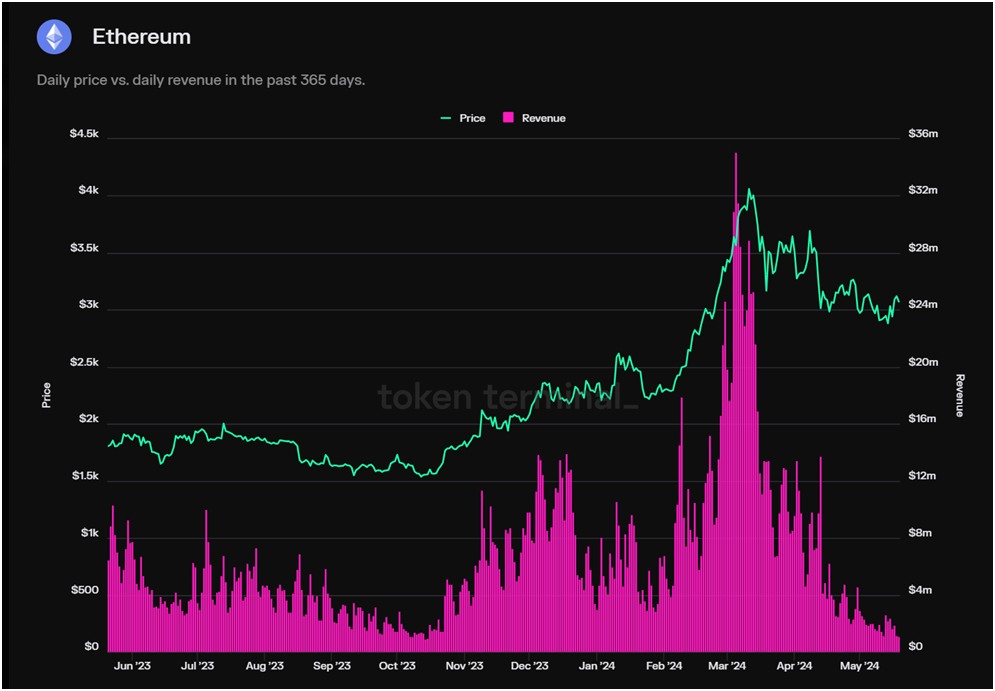
Tron
Revenue Source: Tron earns revenue by levying fees on TRX transactions, which are then burned to drive the token's deflation.
Tron is an Ethereum alternative that focuses more on Asian markets. It was launched in 2017 by Justin Sun, an extravagant crypto entrepreneur known for paying $4.5 million for a charity dinner with Warren Buffett.
Tron, which uses a more efficient but centralized Delegated Proof of Stake (DPoS) consensus algorithm, is currently the 14th largest blockchain network in the world.
With over $9 billion in TVL, Tron is the second-largest DeFi player after Ethereum. However, it has an isolated ecosystem, and almost $7 billion of the TVL comes from its lending protocol, JustLend.
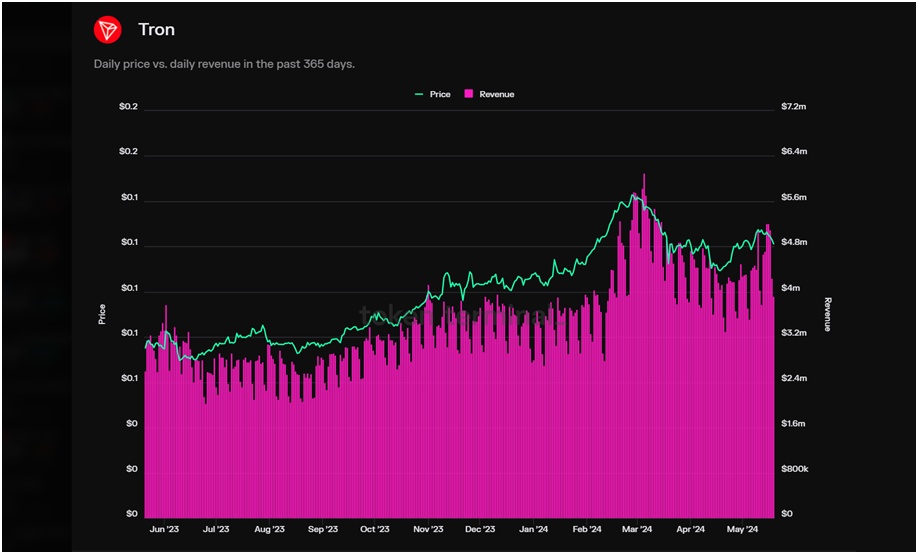
Maker DAO
Revenue Source: The platform generates revenue from the interest paid by borrowers, liquidated collateral, and the fees paid to maintain the DAI peg.
Maker is one of TVL's largest DeFi apps, with over $9 billion worth of crypto in its smart contracts.
The Ethereum-based protocol acts as a lending platform and a money system, issuing its USD-backed stablecoin called DAI.
Maker’s daily revenue fluctuates below $1 million, with occasional spikes to over $1 million and even $10+ million. The metric shows a lower correlation to the token price. However, these charts clearly show a link between Ethereum and Maker DAO revenue streams, most likely because Maker is built on top of Ethereum. Due diligence for Maker DAO will almost certainly include research and analysis of ETH as well.
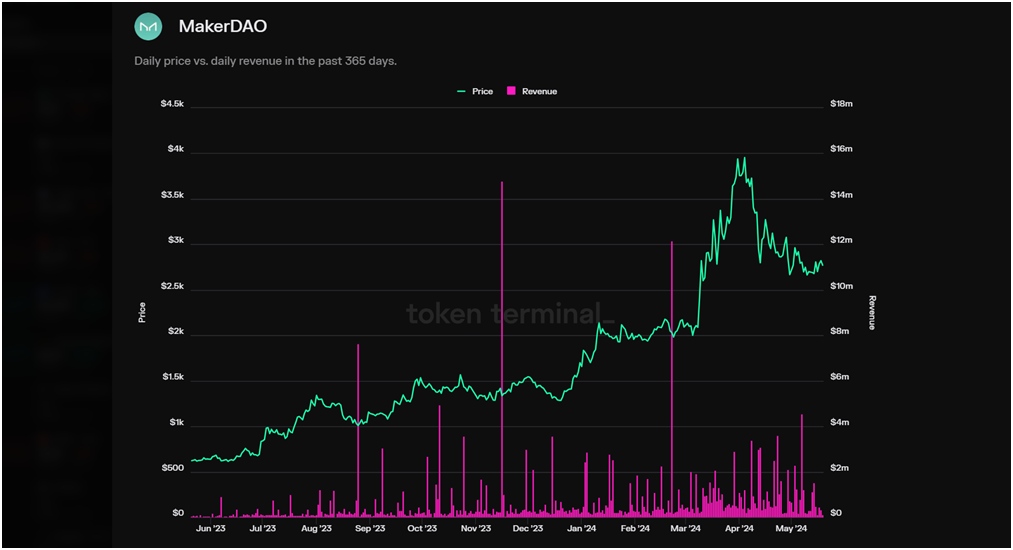
Solana
Revenue Source: The network employs a fee system in which 50% of all fees reach validators, and 50% is burned. As per Token Terminal, revenue peaked at over $2.5 million in March.
Since the beginning of 2023, Solana has been the fastest-growing blockchain network, occasionally overtaking Ethereum on several fronts, such as NFT trading volume and DAUs. It also has a vibrant DeFi ecosystem, attracting about $5 billion in TVL.
Solana has more active users and transactions daily than Ethereum and could secure higher revenues. However, it charges much lower fees than Ethereum, meaning it will have to make it up in the volume of transactions (i.e., more users transacting on Solana more frequently).
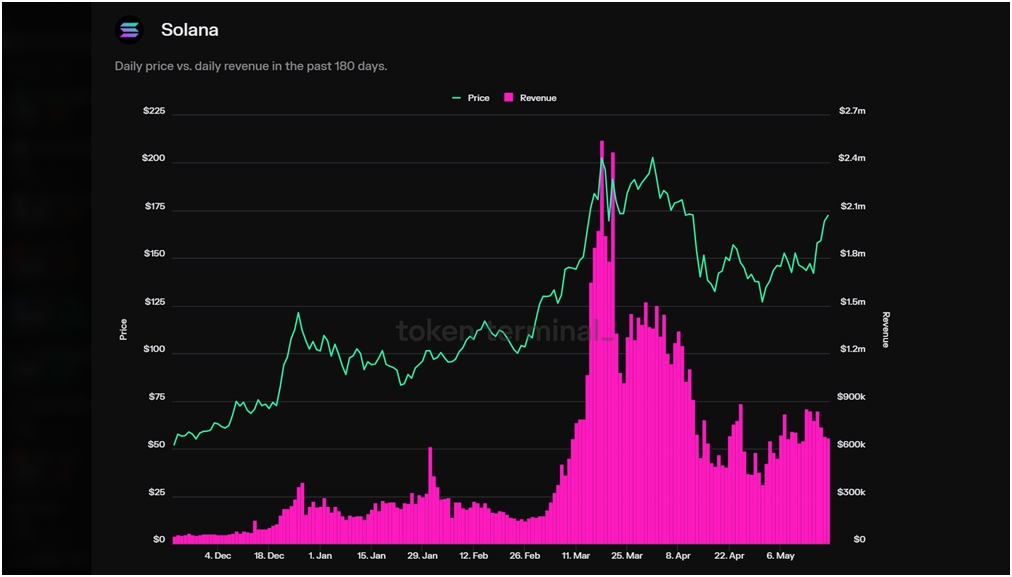
Avalanche
Revenue Source: Avalanche is supported by transaction fees paid in AVAX that are burned after the transaction.
Avalanche is a Layer-1 blockchain that focuses on efficiency and interoperability. It shares similarities with Ethereum by leveraging the Solidity programming language to enable developers to build apps compatible with both networks.
Avalanche’s top position in terms of revenue is mainly due to a surge in transaction fees at the end of 2023. In December, the network’s fees surged to $53 million. That was over 25 times higher than the revenue recorded last April. When December will be excluded from the timeframe, Avalanche will rank much lower, as it generates less than $3 million per month in fees.
The surge in transaction fees was driven by demand for inscription-based NFTs as part of a social experiment introduced by the Trader Joe app.
The subsequent correction in transaction fees hasn’t affected the price of AVAX.
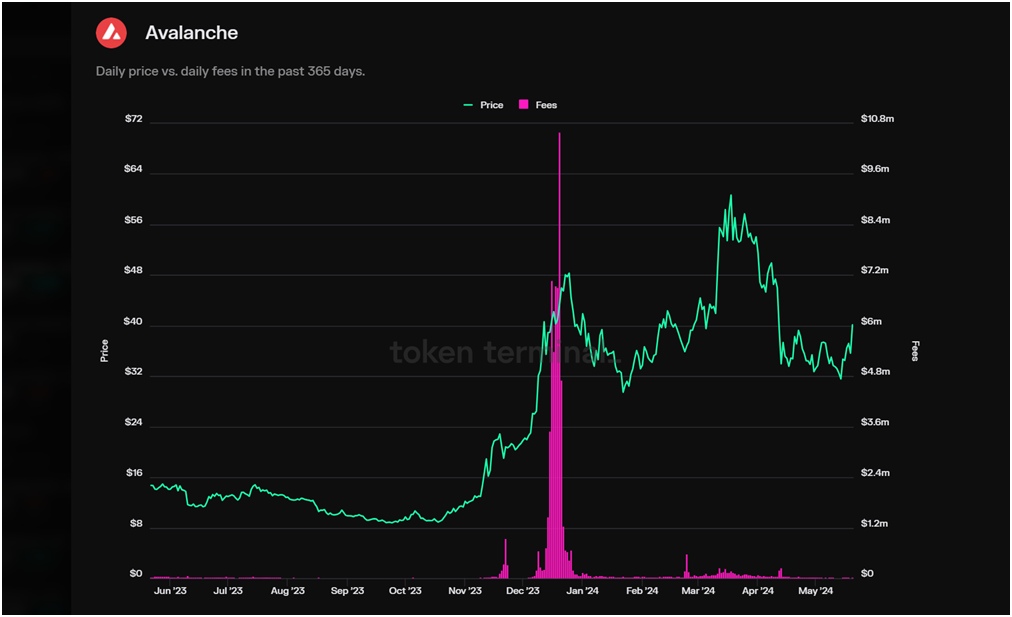
Investor Takeaway
Evaluating crypto projects through key metrics like DAUs, revenue/fees, and market cap provides insights into their health and long-term sustainability.
Projects generating high revenues, such as Ethereum and Solana, demonstrate strong demand and utility, suggesting long-term resilience and potential for growth.
To dive deeper into these metrics, explore our detailed pages on DAUs, revenue, daily active developers, and market cap. Understanding these elements is crucial to making informed investment decisions in the speculative crypto market.
Subscribe to Bitcoin Market Journal to discover more blockchain projects with growth potential.

